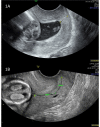Preterm Birth: Screening and Prediction
- PMID: 38146587
- PMCID: PMC10749552
- DOI: 10.2147/IJWH.S436624
Preterm Birth: Screening and Prediction
Abstract
Preterm birth (PTB) affects approximately 10% of births globally each year and is the most significant direct cause of neonatal death and of long-term disability worldwide. Early identification of women at high risk of PTB is important, given the availability of evidence-based, effective screening modalities, which facilitate decision-making on preventative strategies, particularly transvaginal sonographic cervical length (CL) measurement. There is growing evidence that combining CL with quantitative fetal fibronectin (qfFN) and maternal risk factors in the extensively peer-reviewed and validated QUanititative Innovation in Predicting Preterm birth (QUiPP) application can aid both the triage of patients who present as emergencies with symptoms of preterm labor and high-risk asymptomatic women attending PTB surveillance clinics. The QUiPP app risk of delivery thus supports shared decision-making with patients on the need for increased outpatient surveillance, in-patient treatment for preterm labor or simply reassurance for those unlikely to deliver preterm. Effective triage of patients at preterm gestations is an obstetric clinical priority as correctly timed administration of antenatal corticosteroids will maximise their neonatal benefits. This review explores the predictive capacity of existing predictive tests for PTB in both singleton and multiple pregnancies, including the QUiPP app v.2. and discusses promising new research areas, which aim to predict PTB through cervical stiffness and elastography measurements, metabolomics, extracellular vesicles and artificial intelligence.
Keywords: QUiPP; cervical length; fibronectin; preterm labor; screening.
© 2023 Creswell et al.
Conflict of interest statement
The authors report no conflicts of interest in this work.
Figures


References
-
- Howson CP, Kinney MV, Lawn JE. March of dimes, PMNCH, save the children, WHO. In: Born Too Soon: The Global Action Report on Preterm Birth. Geneva: World Health Organization; 2012. Available from: https://iris.who.int/bitstream/handle/10665/44864/9789241503433_eng.pdf?.... Accessed November 28, 2023.
Publication types
LinkOut - more resources
Full Text Sources

